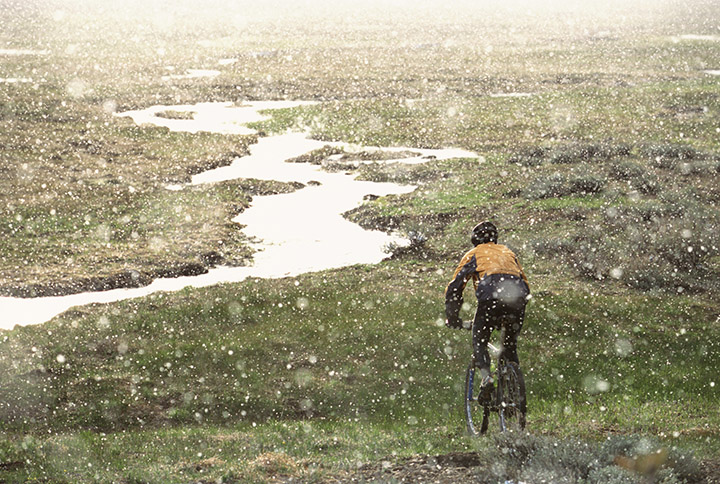Fine conditions and blue skies encourage everyone to get out and about, including photographers, but it’s worthwhile taking your camera out in more extreme conditions, says Robert Keeley.
Everybody loves to take their camera out when the weather is fine. Sunny skies and warm balmy days, or the calm stillness of a quiet winter’s day, are often great for making photographs. And most experienced outdoor shooters understand the value of “getting up early and shooting late”.
Early morning light and dusk can provide endless opportunities for serious photographers to capture great pictures. But if you want to expand your outdoor photography, you should think seriously about also getting out into more challenging weather conditions.
Rain, strong winds, and even dense foggy days, all offer plenty of potential for creative image making. In fact, often these extreme weather events can present a lot more options for serious outdoor shooters than more benign climatic conditions. But you need to be well prepared, and to take into account any potential dangers which might present themselves – to both your equipment, and yourself.
Here’s a few ideas you can work with the next time you want to brave the not-so-great outdoors......

Most people head indoors once the weather deteriorates but, with adequate protection for yourself and your kit, dramatic images can be achieved. Rain offers the chance to capture shots with a different look and feel compared to what we usually see. (Thinkstock.)
01 SHOOTING IN THE RAIN
Most photographers simply give it away if they look out the window and see rain and miserable conditions. The reaction is understandable – it’s not pleasant to head outside and get bucketed down upon! But occasionally, it might be a good idea to fight your natural instinct and get out into the wet. Shooting during rain, and just afterwards, can offer dramatic creative rewards. It’s worth noting that skies often become very clear just after rain storms as the rain removes dust and particles from the atmosphere. The trick in shooting during rain is to make sure both you, and your equipment, is as prepared as possible for the difficult conditions. If you plan to photograph in the wet, start by checking the Weather Bureau website the day (or days) before.
Shooting in arduous conditions requires advance planning. First you need adequate protection for yourself. There’s nothing more debilitating to your creativity than being cold and uncomfortable. Sometimes it might be unavoidable, but you can certainly do your best to avoid discomfort and thereby stay focussed on all your potential photo options. Keep some protective clothing (with a built-in hood) handy, but make sure it’s highly flexible. I look for waterproof jackets which are a bit baggy, under which I can then hide my camera if I’m getting showered in too much rain (or ocean spray if I’m at a wild seaside location). It's even worth thinking about carrying a small foldable umbrella which can fit in a coat pocket or in a strap on your camera bag. If they're light, they're not too hard to hold.
In truly arduous conditions it may simply be impossible to avoid getting rain on your kit. Such are the challenges of shooting in bad weather!

In urban locations rain provides plenty of opportunities for interesting images as artificial lights are reflected and distorted by wet surfaces. (Thinkstock.)
02 PLAN FOR PROTECTION
If you can’t avoid the rain at least search out a nearby spot where you can find some degree of shelter. This may be an awning or doorway in an urban locale, or a tree, shed, or rock ledge if you’re in the bush or at the seaside. Make sure you have two small hand towels and a soft cloth to clean your kit. If it’s raining steadily you’ll quickly soak a small hand towel, so a back up is important. Taking periodic shelter will allow you to wipe your camera. And make sure you have lens cleaning cloths or tissues as well. Blotches of water on your lens can ruin an image (though on occasion I’ve been known to leave them for creative reasons).
Naturally, as soon as you’re back indoors, you should carefully clean your whole kit. Some cameras are waterproof or water resistant, but they’re usually at the higher end of the market. Less expensive kits can be surprisingly robust, but leaving water on any camera for too long is never a great idea. If you want to attempt this type of shooting on a regular basis it’s also a good idea to look at waterproof or water-resistant camera bags. Some bags sell with separate covers for rain protection. They can be fiddly, but if you’re considering travelling a long way in the bush with dicey weather on the horizon they are well worth investigating.

Look for abstract elements in natural and urban environments. (Thinkstock.)
03 KEEP CREATIVE
Creatively, don’t be afraid to innovate. Other than shooting directly upwards, there are lots of possibilities for interesting images in the rain. Often the weather will be grey and gloomy, so higher ISOs could be required, especially if you want a faster shutter speed to freeze moving people or vehicles. But in urban settings people with umbrellas, dark laneways, reflected headlights, starkly lit shops and neon signs are all good raw material.
In the bush the gloom may be challenging, but the even light which results from it will eliminate harsh shadows. Rivers and creeks will usually be flowing more, and clouds can create interesting effects, especially if the sun occasionally breaks through. Just be careful near fast-running creeks or the seaside. Creeks might rise, and King tides (as well as huge breaking waves) can occur in wild conditions by the ocean.
Sun showers offer great opportunities to capture unusual lighting. (Thinkstock.)
In part two of this series, to be published next week, Robert Keeley explains how to shoot great images in fog and windy weather.









